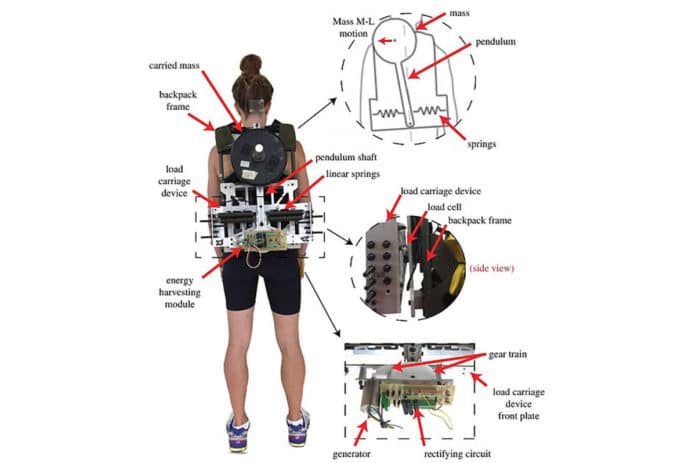A couple of engineers – Jean-Paul Martin and Qingguo Li – from Queen’s University, Canada, have designed a backpack-like device that harnesses the energy from the side-to-side movement of a person walking.
Portable electronics (and our reliance on them) are limited by maintaining continuous power source for their operation. This is especially a problem for people to work or live in remote areas with no access to the power grid. Such people, including military, field scientists, disaster relief workers, and recreational enthusiasts all rely on portable electronic devices like GPS navigation systems, phones, emergency beacons or radios.
However, when considering trips of extended duration in remote areas, it may become impractical to carry enough batteries to keep such devices powered.
In response, the researcher’s device is designed to capture energy from a body swaying from side-to-side, which is what happens when a person is walking.
The energy harvesting backpack consists of a weight attached to the top part of a pendulum, which swings back and forth as a person is walking and the weight gives it more momentum. And the bottom part of the pendulum meets the springs on either side of the device, which are connected to the energy harvesting module.
The whole set up is encased in a frame that the user can wear like a conventional backpack. The energy harvesting backpack weighs around 5 kg (11 lbs).
Related: Indians teens invented a device that helps you charge your phone by walking
During the tests, researchers found that generating more electricity required adding more weight to the pendulum. When the user walked with a 9kg (20lbs) weight, the device generated around 0.22 Watts of electricity, which is enough to power an emergency beacon or a GPS handset. Moreover, adding 35 more pounds (lbs) of weight allowed the device to generate enough electricity to power a smartphone.
Read more: Mobius Backpack by Tentree is made of Algae and plastic bottles
The main, very promising advantage of the new energy harvester is that the user does not have to engage in any other activity to generate electricity, such as cranking a handle. Additionally, the energy comes with no extra physical demands on the wearer beyond that of carrying the weight of the device itself. Unlike the solar panels, the harvester can work whatever the weather.
Future plan is to continue working on the design with the goal of reducing weight without loss of power generation, researchers wrote in their paper published in Royal Society Open Science.
